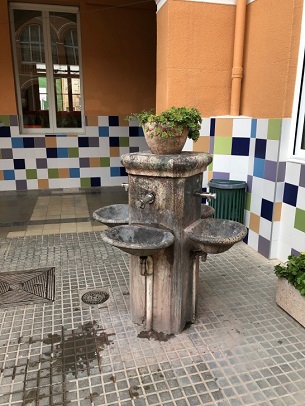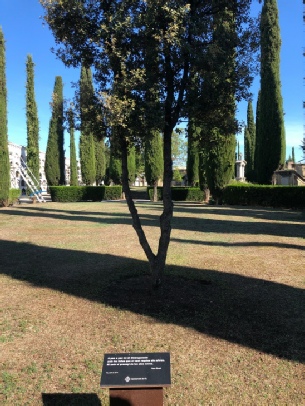Alice Glasnerová
Blogs:
2017
Thank you, Senator McCarthy: 18 Aug, 2017
Noel Field, soviet spy: 10 Sept, 2017
The
hunting dog finds a scent: 30 Sept, 2017
My past ghost: 24 Oct, 2017
Two worlds: meeting Alice for the first time: 26 Nov, 2017
2018
The London connection: 14 Feb, 2018
Stepping into the shadows: 13 March, 2018
Return
to the land of milk and honey: 22 April, 2018
Return to Czechoslovakia: 7 June, 2018
Dual
heritage: 18 June, 2018
Zilina, then and now: 1 July, 2018
A fateful triangle: Erwin, Noel Field and Alice: 29 Aug, 2018
Friends forever: 23
Oct, 2018
Lost luggage: 6 Nov, 2018
Questions of right and wrong: 20 Dec, 2018
2019
Letters from Alice: 26 Jan, 2019
A tale of two photographs: 1 March, 2019
In her father’s steps she trod: April 17, 2019
Prison visit: May 21, 2019
Cartoons and correctness: May 27, 2019
Visiting the dead: June 10, 2019
Alice in the archives: June 21, 2019
Dislocated worlds: May 12, 2019
Au revoir and not good-
Bienvenida Espana: 8 September 2019
Bullfighting in Albacete: 9 September 2019
Benicasim -
Surrounded by danger: 21 September 2019
Arrivals and departures: 29 September 2019
A place of execution (A cold afternoon): November 29, 2019
Seventy years on: 4 December 2019
Windows into the past: 10 December 2019
2021
Munich revisited: February 28, 2021
Will there be a Holocaust museum in Prague?: October 10, 2021
Statue wars: October 14, 2021
Transitional objects: October 21, 2021
My blogs
Surrounded by danger
September 21, 2019

Interbrigadist Hospital in Mataro, now a school
On the 6th and 7th April 1938 the whole hospital of Benicasim was evacuated. Convalescents were sent to Barcelona and the wounded transferred north to Mataro by train, lorry and ambulance. The move to Mataro was precipitated by the Nationalist advance towards the eastern coast of Spain, which threatened to cut Benicasim off from the Republican government in Barcelona. The Republican administration had been forced to move east from Albacete to be in safer Republican territory.

We too made the journey north to Mataro, conscious that we were edging ever closer to France, our days in Spain, like Alice’s, were running out. We arrived in Mataro under threatening grey clouds, which soon turned into pounding rain. In 1938, when Alice arrived in the town, her dark clouds were as much metaphorical as literal, for it was obvious that the Republic’s days were numbered. Before evacuating Benicasim, they had seen the flights of Italian aircraft from Majorca heading over the beach towards the Spanish mainland, sometimes they would strafe the beach or drop an ordnance as they headed for their true destination.

Fishermen’s houses in Mataro
Like Benicasim, Mataro is on the coast, but when Alice and the others arrived, the coast was not a pleasure beach but lined with small fishermen’s houses. The hospital, a large building, formerly used as a Catholic school and monastery, was outside the town, surrounded by countryside. Whereas in Benicasim, the railway brought the wounded directly to the hospital, in Mataro they needed to be transported up by tram or lorry. Now, the building is once more a school and in the midst of the newer part of the town, as Mataro has grown into a thriving industrial city.
We were there to meet Josep, a retired teacher and committed researcher, who is uncovering the work of the hospital and international brigades. He is also a proud Catalan, campaigning for Catalonian independence. His interest in the hospital came through his grandparents. His grandmother worked at the hospital and she and her husband also had three of the nurses as lodgers, sharing one large bed. Luckily, as they worked in shifts they were rarely all in it at the same time!


We accompanied Josep into the school, it was the day before term started and the teachers were in but not the students. We had to leave by 12 as the school was closing for all the teachers to go to mass and then they would be going out for lunch together, so different from our own training days! Josep explained that the chapel, which was at the entrance to the school, was used as a triage centre by the hospital. We walked around the original staircases, saw the original water fountains in the courtyard, visited the canteen, still being used for the same purpose, and then went down into the basement which had housed the kitchen and stores and where some of the original tiles still graced the walls. I imagined Alice down there, taking deliveries through the roadside door that led directly to the basement.
Josep explained that the hospital had housed about 800 patients, many with beds in
the corridors as well as in the classrooms-

Memorial at Mataro Cemetery
After leaving the school, we made our way through the pelting rain up to the cemetery to see the memorial to the international brigades, it was large and undamaged, perhaps a sign that Mataro is still a socialist town. The place where the bodies were actually buried, however, was unmarked, next to another patch of land housing the dead from the Nationalist side, who were overlooked by a large cross. Josep wants a large plaque on the outer wall of the school, but he is encountering some resistance to this. He is welcomed into the school to show people round and visit, but he has not yet been able to talk to the students. One of the history teachers is interested in the subject and some students have written papers on the role of the school in the civil war, but always, he says, from a Nationalist point of view.
Two days later we visited Vic, Alice’s final placement, and by then the weather had reverted to hot sun and blue skies. There, we were met by Manel, a police officer with the traffic division, who has become a committed campaigner for the memory of the international brigades. His family had no personal connection with the hospital, unlike Guillem’s and Josep’s, but he became interested one year at All Souls in the town’s cemetery when a young woman asked him in English for help finding the grave of Kevin Rebbechi. Finally they found the name, covered in moss, on a memorial to members of the international brigades, more of a headstone with a list of names than a memorial, as no mention is made of the international brigades. Thus began a long relationship between Manel and the Rebbechi family, as he started to research the history of this man and his town. He has now written a book, Looking for Kevin, about his experiences.
Manel had arranged for us to park outside town and he drove us to the cemetery where the spark for his own interest in the subject had first been lit. We saw the very small plaque with Kevin’s name and some of the others from the international brigades, now cleaned and easy to read. A tree had been planted and another small plaque with a poem, but still no mention of the brigades. The men had been buried in an unmarked patch of ground, as in Mataro. Here, however, rather than looking bleak under grey skies and pouring rain, it was a peaceful scene, with two brown rabbits quietly nibbling the short grass.


The cemetery in Vic
From there we went to the hospital, again located in a Catholic school, this time attached to a convent. The building dates from the late 17th century and the adjoining church is the only one left standing by the Republicans. By the time Alice got there, it was one of the last outposts, well defended by a small airfield and impossible to bomb from the sea, as it is in the mountains 60 kilometres inland from Mataro. All the wealthy and powerful people had long since deserted the town, the poor who remained had, to quote Manel, “no food, no drink, no water.” There was no mains water in the town anyway, it all had to be collected from the wells. As a result, typhus was rife and whereas the international doctors knew how to avoid it and treat it, those in the town did not. Although the hospital was better off than the townspeople, it had no morphine and the operations were carried out under the light of a single bulb held aloft by one of the nurses. The day we visited, the school term had started and when we first walked out into the courtyard it was obviously break time and the courtyard was filled with teenagers chatting peaceably. It seemed a very long way from the cries of wounded men and the terror of knowing that everyone’s days of freedom were numbered.


There were no more illusions by the time Alice was in Mataro and Vic. Danger was
on all sides; the inexorable advance of Franco’s troops and the cruel reprisals that
faced every town that was overrun were well-
It was through him that Alice, Dora, Vlasta and Helena were all accused of undermining morale, first in Benicasim and then also in Mataro and Vic, where they were kept under surveillance and had their post intercepted. They were accused of having stolen some preserves, of which crime they were later acquitted, but these same accusations resurfaced ten years later when they were imprisoned in Czechoslovakia. Many pages of interrogation focus on Spain and those final weeks; the Soviets had very long memories and very detailed records.

Alice, Vlasta and Dora on the beach at Mataro
Alice was lucky, she decided to leave Spain in July 1938, those who left much later had an even more difficult time. We too, were about to leave, but before we did, we sat and chatted with Manel over a coffee. He alone in Vic is uncovering these stories and although the schools know him well and welcome him in to talk about road safety, he is not welcome to talk about the town’s history. The book he has written is not approved of by his superiors, but that is not stopping him. His next project is to memorialise the Spanish refugees who escaped into France and were then shipped to concentration camps, primarily Mathausen.
As we drove away, two sentences of Manel’s stuck with me, “People of Vic no talk.” and “Spain can never bury her dead.”